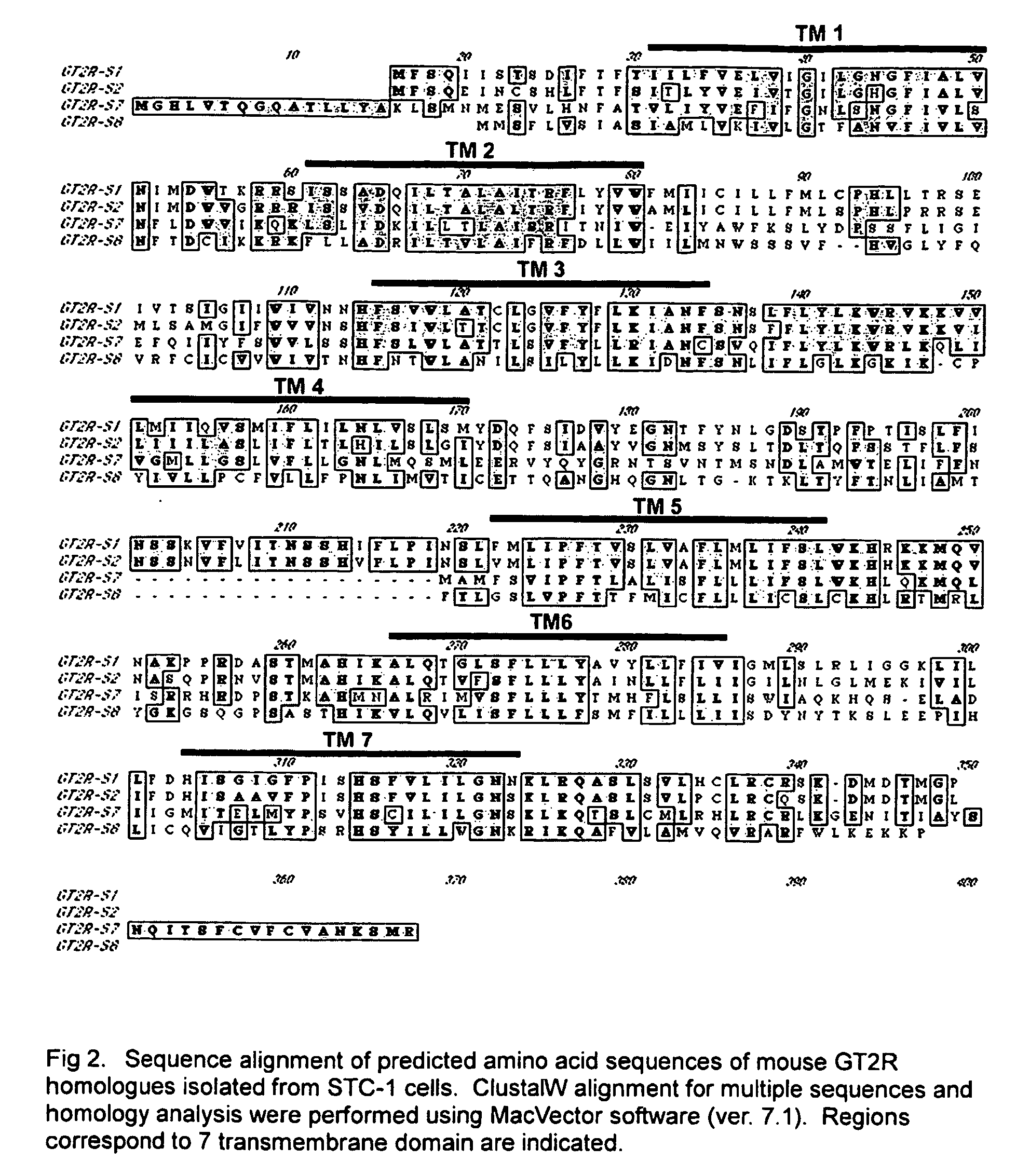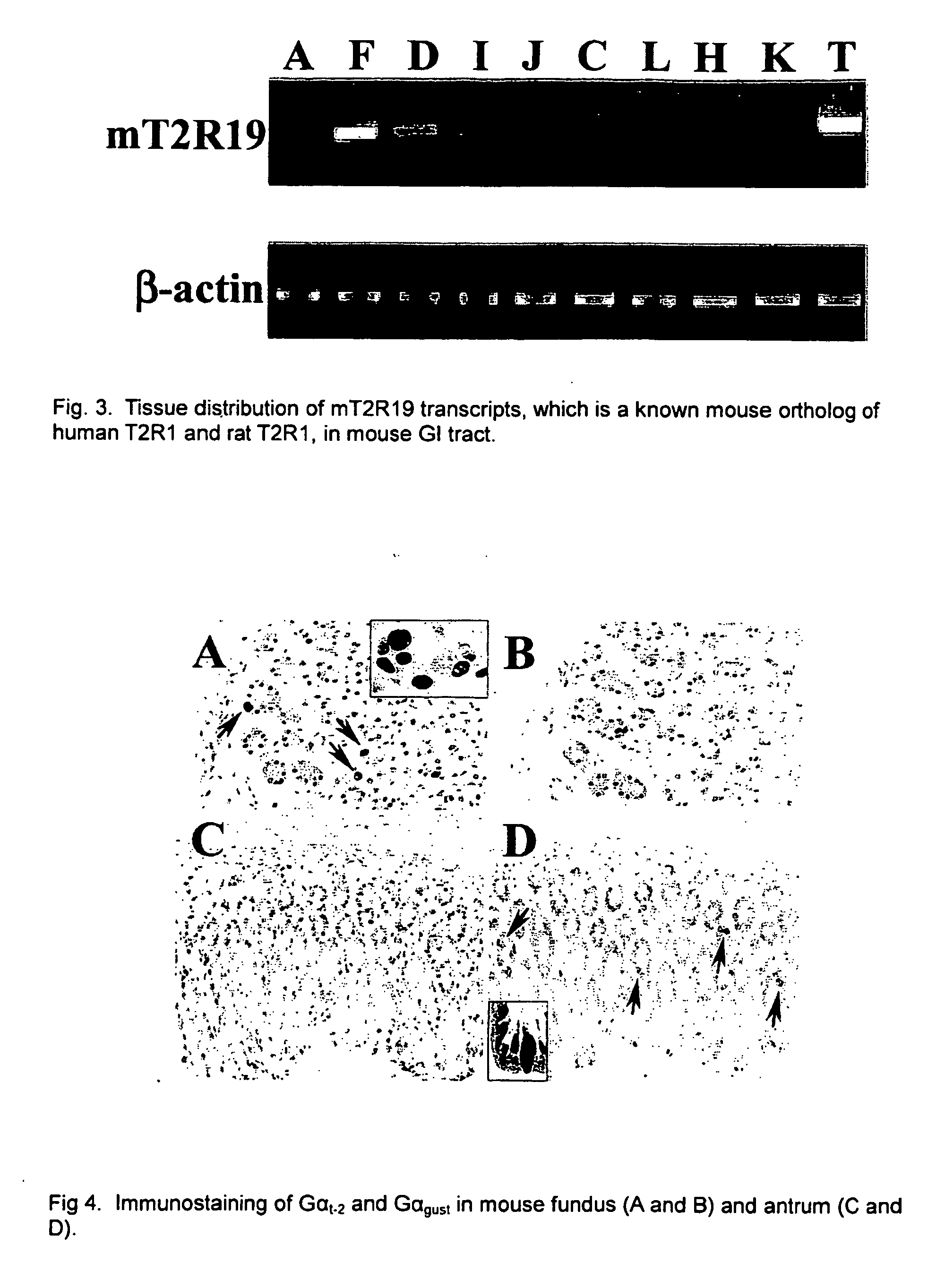Gastrointestinal chemosensory receptors
a gastrointestinal chemosensory and receptor technology, applied in the field of gastrointestinal chemosensory receptors, can solve the problems of elusive initial molecular recognition events that sense the chemical composition of luminal contents, and achieve the effect of reducing the number of gastrointestinal chemosensory events
- Summary
- Abstract
- Description
- Claims
- Application Information
AI Technical Summary
Benefits of technology
Problems solved by technology
Method used
Image
Examples
example 1
Expression of Ggust Gt-2 and GT2R in STC-1 Cells
[0111] The enteroendocrine cells play a critical role in the integration and coordination of multiple physiological responses including motility, release of gastrointestinal hormones and pancreatobiliary secretion. We hypothesized that these cells could play a role in sensing the chemical composition of the luminal contents. As a first step towards testing this hypothesis, we examined whether the intestinal STC-1 cell line, a mixed population of gut endocrine cells (Rindi et. al., Amer. J. Pathol. 136:1349-1363 (1990)), express members of the T2R family as well as Gα subunits of G proteins implicated in intracellular taste signal transduction.
[0112] RT-PCR and sequencing revealed the presence of transcripts for Gαgust and Gαt-2 in STC-1 cells (FIG. 1A). Furthermore, Western blot analysis of STC-1 cell lysates using specific antibodies directed against Gαgust and Gαt-2 revealed immunoreactive bands of 42-46 kDa which were extinguished...
example 2
GT2R from STC-1 is a Taste-sensing Receptor
[0116] Amino acid sequences were deduced from cDNA clones of STC-1 or from the genomic clones isolated from the mouse genomic DNA libraries (FIG. 2). This analysis revealed that mouse GT2R-S1 and S4 are novel sequences that have 84 and 75% homology to rT2R2 and GT2R-r22, respectively. Mouse GT2R-S1 was further found to express in mouse fundic, antral and duodenal mucosa tissues. The mouse GT2R-S2 gene is closely related to mT2R23 with 7 amino acid substitutions and the GT2R-S7 is almost identical to mT2R2 with only 2 amino acid changes. The latter two transcripts may represent variants of existing mT2R. Similarly, mouse cDNA clones GT2R-S5-1 and S7-4 are virtually identical to mT2R7 and mT2R30 and thus may be the variant forms of these genes. However, genes encoding full-length GT2R proteins are needed to confirm their true identity.
[0117] Having demonstrated that STC-1 cells express Gαgust, Gαt-2 and multiple GT2Rs, we examined whether t...
example 3
Expression of Gustducin (Gαgust) and Transducin (Gt) in Rat and Mouse GI Tissues
[0120] In order to identify Gαgust expression in the GI tract, reversed transcribed mRNA isolated from rat antral, fundic and duodenal mucosa was subjected to PCR using specific primers based on the rat Gαgust sequence (FIG. 7). A major PCR product of the predicted size (332 bp) was obtained from each of these tissues. Interestingly, PCR amplification of a cDNA library enriched in rat gastric endocrine cells using the Gαgust specific primers also produced a 332 bp fragment. Sequence analysis verified that these PCR products corresponded to amplified Ggust. We confirmed the identity of gastric Gαgust by cloning and sequencing cDNA fragments encoding the entire open reading frame of Gαgust from the gastric endocrine cell cDNA library.
[0121] The α subunit of transducins 1 (Gαt-1) and 2 (Gαt-2), originally thought to be expressed only in photoreceptor cells of the retina, are also present in vertebrate tas...
PUM
| Property | Measurement | Unit |
|---|---|---|
| Fraction | aaaaa | aaaaa |
| Fraction | aaaaa | aaaaa |
| Length | aaaaa | aaaaa |
Abstract
Description
Claims
Application Information
 Login to View More
Login to View More - R&D
- Intellectual Property
- Life Sciences
- Materials
- Tech Scout
- Unparalleled Data Quality
- Higher Quality Content
- 60% Fewer Hallucinations
Browse by: Latest US Patents, China's latest patents, Technical Efficacy Thesaurus, Application Domain, Technology Topic, Popular Technical Reports.
© 2025 PatSnap. All rights reserved.Legal|Privacy policy|Modern Slavery Act Transparency Statement|Sitemap|About US| Contact US: help@patsnap.com



